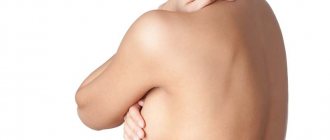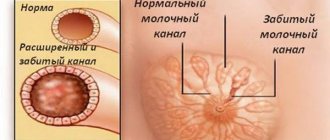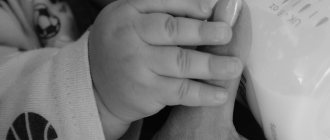??Breast massage for nursing mothers with lactostasis (milk stagnation) ??
The period of breastfeeding cannot be called simple and easy for a young mother; in addition to the banal lack of sleep and fatigue, various unpleasant physiological conditions and pathologies often arise. These are painful cracks in the nipples, insufficient or excessive amounts of milk, stagnation of milk (lactostasis) and, as a result, mastitis.
A woman can cope with most of these troubles on her own, but with lactostasis, and even more so with mastitis, a doctor’s consultation is required. Stagnation of milk without an appropriate reaction turns into mastitis, and this is a serious pathology, fraught not only with the cessation of lactation, but also with serious problems with the woman’s health in the distant future.
Causes of pathology
Stagnation of milk in the breast is not a disease, but a condition in which constantly arriving milk clogs one or more ducts - the so-called milk plug. This causes severe discomfort, which forces some women to even give up feeding their baby in favor of artificial formula.
The occurrence of lactostasis is possible at any stage of breastfeeding, but more often it occurs in the first three weeks after birth, after the end of colostrum production. Then the milk begins to actively flow, but the breasts are not ready for this or the woman is not caring for it correctly.
A sudden flow of milk leads to breast enlargement, often accompanied by pain, the appearance of lumps, and an increase in temperature.
The causes of lactostasis begin in the period before childbirth and in the first weeks of feeding; there are also physiological reasons:
- the woman did not develop her breasts before childbirth;
- milky passages are narrow and short in length;
- flat nipple;
- endocrine disorders;
- mammary gland injuries;
- infrequent breastfeeding;
- the woman herself provokes stagnation by constantly squeezing her breasts in one place during feeding;
- short feeding time from one breast;
- sleeping on your stomach;
- long breaks between feedings (more than 7-8 hours);
- mother's overwork;
- uncomfortable bra;
- expressing the breast until it is completely empty, which causes a sudden supply of new milk, which the baby cannot eat.
But the most important and common reason is the baby’s incorrect attachment to the breast from the first feedings. If a child does not grasp the nipple correctly, then he sucks milk from the same ducts, and some remain inactive, which causes stagnation and blockage of the passages.
To get stagnant milk to circulate, there are several methods that are best used in combination:
- learn how to properly attach the baby, taking into account the place where the stagnation occurred;
- proper expression of leftovers after feeding;
- massage for lactostasis;
- physio- and water treatments;
- correct drinking regime;
- comfortable underwear;
- prevention of lactostasis.
There are many reasons for this:
- Baby regimen: feeding strictly at a certain time, and not at the request of the child in the first 1-2 months of life, when lactation is established
- Mistakes in attaching a baby to the breast
- Cracked nipples due to improper feeding technique
- Breast injuries
- Sleeping on your stomach
- Physical overexertion
- Anxious state
- Overwork
Despite the common causes of lactostasis, according to statistics, only 3% of women are not capable of full breastfeeding. It follows that the remaining 97% can have productive lactation and feed the baby as much as they decide.
Manifestations of lactostasis
Swelling appears at the site of congestion in the chest. The skin over it turns red and becomes hot to the touch. You can feel the area of compaction under your fingers. The woman experiences discomfort, and often severe pain, and her body temperature rises.
What are the benefits of breast massage?
It is categorically unacceptable to let the appearance of stagnation take its course - it will not resolve on its own, although such a misconception exists. There are two options:
- residual compactions are formed, invisible to the woman, which can subsequently cause mastopathy, the appearance of cysts, benign and malignant tumors;
- infectious inflammation of the mammary gland - mastitis, a dangerous disease in which breastfeeding has to be suspended due to complex treatment with antibiotics and even the need for surgical intervention.
Therefore, at the first manifestations of lactostasis, you should immediately begin to fight this serious problem. One of the most effective methods is breast massage.
Preventive kneading and massaging should begin on the 4th day after the birth of the child, at which time colostrum ceases to be released and milk production begins. It can be performed by a specialist massage therapist, one of the relatives, or the woman herself - while learning the basics of manipulation. A pediatrician or massage therapist at a clinic can teach this.
The benefits of this procedure are as follows:
- breaks up pockets of stagnation and hardening in the chest;
- disperses swelling;
- softens tissues;
- removes milk that has stagnated in the ducts;
- promotes stretching of passages and free circulation of fluid;
- prevents the onset of inflammatory processes;
- stabilizes the process and feeding schedule;
- helps to get rid of panic and fear, to have a positive attitude towards breastfeeding for a longer period of time.
Massage technique
General requirements for how to do breast massage when lactostasis has developed are as follows:
- session time is 20-30 minutes, 1 or 2 times a day, optimally after morning and evening feedings, before pumping - then you can clearly identify all the seals;
- performed while sitting, with both hands, first on the breast with compaction, then on the second gland (even if there is no stagnation there), then again on the first;
- movements should be smooth, soft, gentle, the direction should be from the periphery of the gland to the nipple (it is forbidden to rub it back - this will force the milk inside, and congestive foci will increase).
Before we describe the massage technique for lactostasis in nursing mothers, let us remind you once again what absolutely cannot be done:
- stop feeding the baby from the affected breast;
- make intense, sharp and strong movements;
- use warm compresses and ointments;
- stop the procedure even if there is a feeling of discomfort.
The algorithm for performing a massage during milk stagnation is as follows:
- lightly warming the chest with a heated diaper or a warm shower;
- smooth rubbing from the edges of the gland towards the nipple;
- take the breast from below with one hand, lift it, massage it clockwise with the other hand, trying to drive the milk to the nipple, express it;
- find lumps by soreness or a red spot (this is how stagnation manifests itself if it is in the deep ducts);
- on this part of the mammary gland, knead, tap, shake;
- again massage the entire gland, driving milk to the nipple, bend over and shake the breast for 30-40 seconds, then express what has collected;
- Finally, dry cold should be applied to the chest (a diaper pre-chilled in the refrigerator, or wrap ice in a bag, then in a towel, or a chilled cabbage leaf).
To facilitate the massage, you can resort to creams and masks, but they should not contain warming ingredients and essential oils (only sage oil is allowed, but on the condition that the baby will not be put to the breast earlier than after 3 hours). The best choice: baby cream or massage oil, Bepanten cream (Pentacrem, Heppiderm), a few drops of olive oil.
In some cases, massaging the breast during congestion causes very severe pain. But you shouldn’t refuse a massage - mastitis is even more painful, and it will take a long time to treat. To reduce pain, doctors recommend performing a massage in the shower at a temperature of 36°C - the water will seem cool and reduce discomfort.
Usually 3-5 massage sessions are enough to eliminate congestion and return the breasts to normal.
But, if the pain increases, or the milk contains an admixture of blood or yellow pus with an unpleasant odor, you should immediately consult a doctor who will prescribe a course of treatment so as not to trigger inflammation.
Types of breast massage for lactostasis and basic rules
Depending on whether a nursing woman has already developed lactostasis, two types of breast massage are suggested - therapeutic and preventive. As is clear from the names, the first type is intended to prevent stagnation of milk in the glands, the second is aimed at eliminating it if the ducts are already clogged. Experts recommend starting preventive sessions from the first days of feeding in order to maintain a full flow of milk.
Therapeutic massage for lactostasis in nursing mothers is carried out in compliance with certain rules:
- kneading the chest should be started from the first days after the symptoms of the problem are detected, otherwise untreated lactostasis will provoke the development of mastitis;
- before starting the treatment procedure, the breasts need to be prepared - doctors advise applying a warm heating pad, a towel or taking a shower to the glands;
- monitor the sensations during the session - the woman should not feel acute pain;
- repeat the procedures until the lumps in the breast completely resolve and the feeding process ceases to cause discomfort.
If the gland duct is blocked, the process of inflammation begins inside. During the first two days, every effort must be made to eliminate the stagnation, otherwise bacteria will begin to multiply in the area of the blockage. This development of events is fraught with the formation of mastitis, often of a purulent nature.
Preventive massage
First, you need to talk about how to properly knead your breasts to avoid the appearance of stagnation and lactostasis. Preventive measures will help not provoke swelling of the gland, maintain full lactation and good flow of milk through the ducts to the nipple. This massage should be done before putting the baby to the breast - this will make it softer, lumps will break up if they have already appeared, and it will be easier for the baby to latch on to the nipple.
Preventive sessions can be carried out independently at home, preferably while taking a shower:
- make movements in a circle from the edges of the chest to the middle, massaging the skin with light pressure with your fingers;
- after 2-3 repetitions, wash the glands with warm water and again repeat the massage movements in a circle.
The water temperature should be comfortable - not cool, but not scalding. The duration of the preventive massage session is 8-10 minutes, after which you need to lightly express the milk and feed the baby.
Therapeutic breast massage for lactostasis
How to do a massage to eliminate signs of lactostasis, if the lumps are clearly palpable, the woman experiences nagging pain in the chest, and the gland itself is hot and dense? Such symptoms require more serious measures than preventive sessions while taking a shower. You cannot perform a therapeutic massage with dry hands, much less allow your husband to act as a breast pump after the session. This can damage the delicate tissue of the nipples and cause infection to enter the gland.
Recommendation! If a woman does not know how to properly massage her breasts to get rid of lactostasis, or is afraid to do it herself, you can ask a specialist for help. A doctor or visiting nurse will come to your home, work on all lobes of the mammary gland, show you the correct technique and help you express the remaining milk.
Preparation
Before talking about the massage technique for lactostasis, you need to dwell on the rules of preparation for the session, this is no less important than the procedure itself. First of all, you need to thoroughly wash your hands and mammary glands. Ideally, you should take a warm shower to relax the muscles and improve the flow of milk through the ducts. The massage should begin immediately after applying the baby to the breast, or expressing (manually or using a breast pump).
The skin around the gland is lubricated with any oil that is in the house - olive or castor, simple vegetable oil is also suitable. The main thing is that the product does not get on the areola and nipple area. For the convenience of massage, it is better for a woman to sit in front of a mirror. If the stagnation is extensive, then the session is carried out not only after feeding, but also before it, and the breast is then rinsed with boiled water.
Technique
How to properly massage the breasts during lactostasis to achieve maximum effect? It must be remembered that strong pressure aggravates pain and swelling, so movements should be smooth and careful. If a woman feels pain during a massage, perhaps she does not follow the technique - in this case, it is worth consulting with a specialist. The rules of massage are simple:
- The gland is supported by the hand, while the second one works over the entire surface of the chest with stroking movements. They start from the base, including the bottom and armpit, and towards the nipple;
- after stroking, spiral movements are made along the gland, also from the base towards the center (3-4 times for each breast);
- circular movements clockwise;
- each breast is taken in hand, squeezed a little and worked in a circle;
- in the area of compaction, the skin is kneaded most carefully, without pressure or sudden movements, but these areas should be given much more time.
How to break up lactostasis so that not only the upper lobes are worked out, but also those located below, at the base of the chest, and in the armpits? Pay attention to each part of the gland, not missing a single area when massaging, while loosening the pressure in the areas of compaction and location of lumps. If the procedure is carried out correctly, after performing the first two sets of movements, milk will begin to be released from the nipple.
Advice! How to properly massage to overcome lactostasis is now clear. You need to end the session by bending over and gently shaking your shoulders. In this position, milk will flow from the glands towards the nipple along the ducts that have expanded during the procedure.
After the massage, the breasts are thoroughly washed and blotted with a towel - now you can start feeding. If during the session it was not possible to completely break the seal, the remaining milk will have to be expressed. This should not be done immediately after application; the body will perceive this as a signal about an insufficient amount of dairy products and will increase lactation, which will aggravate lactostasis. The ideal break between latching and pumping is half an hour.
How to express milk correctly
The procedure for freeing the glands from milk residues after feeding is relevant for most mothers. Some people have an excess of milk and because of this, stagnation is possible, while others have little milk and regular pumping stimulates an increase in its production.
Previously, young mothers were taught that it was necessary to express the rest of the milk after each feeding, “dry” - until the last drop. Now the concept has changed: pumping should only be done under certain conditions:
- if the baby sucks sluggishly, inactive or weak;
- with milk deficiency;
- with excessive production;
- if you need to stock up (travel, medication treatment).
You can perform the manipulation with your hands or use a breast pump; the dishes can be any with a non-slip bottom.
There are several techniques for effectively expressing milk.
Marmet technique. Pumping is performed while sitting, leaning on the back of a chair. You need to hold the milk container with your left hand, grab the gland with your right hand and gently press on the areola with your thumb and forefinger, moving them in the direction of the nipple.
Heated bottle technique. It is recommended to be used when the nipples are too large or tense and the baby cannot fully grasp them. In this case, you need to take a jar with a neck of 4-6 cm, heat the top in hot water, and cool the bottom. The areola should be lubricated with oil and placed in a bottle. The temperature difference will increase the milk and when it begins to come out easily, the bottle must be removed and further expressed by hand.
Breast pump. This device, regardless of design, effectively selects milk with minimal participation from the woman. There is only one subtlety in choosing a breast pump: the diameter of its funnel should be 1-2 cm larger than the diameter of the areola. And during manipulation, the vacuum level must be selected based on personal feelings so that there is no pain or discomfort.
Technique for expressing breast milk by hand
The woman herself decides how to express milk. Doctors recommend following certain rules.
You cannot express milk immediately after childbirth, only after 5-7 days. Experts do not recommend pumping after nine in the evening. Do not squeeze out milk to the last drop and do this procedure more than three times a day. The best solution would be to alternate between breastfeeding and bottle feeding.
Before pumping, it is advised to drink a glass of warm herbal tea, massage the mammary glands, apply a warm towel or take a shower. All this will help the woman relax and express milk as efficiently as possible.
Do not put rough pressure on the breast or nipple. Under no circumstances should the procedure be painful.
A lactation consultant will help a woman master the technique. Your doctor will also tell you how to properly store breast milk after pumping. Correct execution will eliminate many problems, including inflammation of the mammary glands.
Physiotherapy procedures
Along with massage, hardware physiotherapy is often prescribed for large and painful lumps. This accelerates the processes of resorption of stagnant lesions, gives an analgesic, anti-edematous effect, and relieves spasms.
The most effective techniques:
- Ultrasound massage and ultrasound intensity 0.2-0.4 W/cm2. The duration of the daily procedure is up to 5 minutes, the woman does not feel any discomfort. Already after 3-4 procedures there is a noticeable improvement.
- MI - pulsed magnetic therapy is performed once a day, a course of 507 sessions, the procedure lasts up to 7 minutes.
- DM and SM therapy is the irradiation of affected areas with waves of 8-10 W. The duration of the procedure is up to 10 minutes, the course is 8-10 days.
There are strict restrictions on the use of physiotherapeutic methods:
- mastitis and mastopathy;
- fibroadenoma of the mammary glands;
- benign and malignant tumors of the breast and lymphatic system;
- diseases of the central nervous system;
- presence of a pacemaker.
Treatment of lactostasis at home
Breast lactostasis in a nursing mother and its treatment at home is an important task, which competent specialists and recommendations will help you cope with:
1. Stimulation of milk flow: putting the baby to the breast at least once every 2 hours, or pumping as often. Little by little, excess milk will be mechanically eliminated, reducing pressure in the mammary gland and alleviating the woman’s condition. You can express yourself manually, or you can purchase an assistant for this purpose - a breast pump.
Types of devices:
- A pump/breast pump with a bulb is the simplest and most affordable device from a financial point of view. However, frequent use can quickly lead to the formation of cracks, so such breast pumps are more likely for one-time use than for regular use. In addition, due to the constant mechanical squeezing of the pump, the hand gets tired quite quickly, without expressing the entire required volume of milk.
- A piston breast pump is a next generation device. He expresses milk and massages the breasts, thereby preventing lactostasis and other troubles. It does not make noise (which is very important if the mother expresses at night or near a sleeping baby) and is very productive, allowing you to collect at least 200 ml of milk in 10 minutes. An electric device allows you to save time first of all. He expresses both breasts at the same time without the slightest physical effort on the part of the woman. The nozzles have an anatomical shape, the breast pump imitates the sucking of a child and prevents the formation of cracked nipples and stagnation of milk.
2. Taking a warm shower or even a bath, especially before feeding. Can be combined with a gentle massage of the breast using circular movements. Or you can grab your breast with your palms, one from below, the other from above, and use gentle, gentle movements to massage the lump towards the nipple.
3. A timely consultation with a competent doctor or lactation specialist is required (to exclude mastitis as the cause of increased temperature, pain and lumpiness in the mammary gland), who will assess the condition of the breast and give recommendations on the correct feeding technique, if treatment is necessary, including selection special ointments allowed during breastfeeding.
4. A time-tested traditional medicine recipe, according to which compresses from lightly beaten cabbage leaves help with lactastasis.
Tiunova Elena
K.M.N., pediatrician of the highest category, nutritionist
“The use of warm (warming) compresses on the mammary gland is not recommended!
Water activities
To prevent and eliminate stagnation of milk in the breast, water massage is also used. It can be used at home in the form of a contrast shower with a slight temperature difference.
In a clinical setting, the following types are prescribed:
- underwater shower-massage;
- circular shower;
- Charcot's shower.
Prevention of milk stagnation
Preventive measures are not complicated and every woman, using them in full, can avoid lactostasis. The recommendations are:
- positive attitude;
- preparation and regular self-massage of the breast;
- frequent feeding at the baby's request, and not according to the clock;
- duration of feedings - how much the baby needs;
- warm shower before feedings;
- expressing milk as needed;
- a properly selected bra for nursing mothers;
- sufficient drinking regime;
- quality rest and sleep.
A problem such as stagnation of milk in the breast reduces the quality of life of the mother and the nutrition of the baby. If you consistently follow simple rules of prevention, then avoiding lactostasis is not difficult. And if symptoms of stagnation appear, it is best to consult a family doctor or pediatrician and adhere to the prescribed measures - this way, in 2-4 days you can completely return to a healthy state and avoid serious complications.










